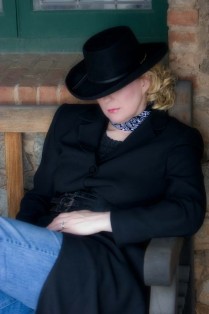 A useful part of the cowboy’s costume was his neckerchief, or “wipes” as he called it. Neckerchiefs were usually red or blue, like the old bandana of the South, or black silk which did not show the dirt. The rodeo rider of modern days goes in for bright colors. Rangemen usually wished to avoid colors which attracted attention. An inconspicuous rider was more apt to catch a rustler. Usually the cowboy wore his neck scarf draped loosely over his chest with the knot in the back. If the sun shone on his back he reversed the scarf to protect his neck. When riding in the drag of a herd he pulled it up over mouth and nose to keep out the dust. In winter he might put it over his eyes to prevent snow blindness or to protect his face from icy winds and stinging sleet. He could use it to tie down his hat, to serve as an ear muff in cold weather, or to keep his head cool on a blazing summer day by wearing it, wet, under his hat. When he washed his face in the morning, an ever ready towel was hanging from his neck. In his work he had this handy mop to wipe the sweat off his face. He could use it for holding the handle of a hot branding iron, for a blindfold on a snaky horse, or as a “pigging string,” that is, a string for tying a roped animal by all four feet the way a hog is tied. Likewise the neckerchief could be used as a makeshift hobble for his horse, a tourniquet a sling for a broken arm, or a bandage. In the movie Appaloosa with Ed Harris and Vigo Mortensen, Mortensen’s character demonstrates just how important the neckerchief was to cowboys. In one scene he is carefully mending a tear in the garment. In addition to all these great uses I’ve found that the neckerchief is perfect for covering unsightly turkey neck.
A useful part of the cowboy’s costume was his neckerchief, or “wipes” as he called it. Neckerchiefs were usually red or blue, like the old bandana of the South, or black silk which did not show the dirt. The rodeo rider of modern days goes in for bright colors. Rangemen usually wished to avoid colors which attracted attention. An inconspicuous rider was more apt to catch a rustler. Usually the cowboy wore his neck scarf draped loosely over his chest with the knot in the back. If the sun shone on his back he reversed the scarf to protect his neck. When riding in the drag of a herd he pulled it up over mouth and nose to keep out the dust. In winter he might put it over his eyes to prevent snow blindness or to protect his face from icy winds and stinging sleet. He could use it to tie down his hat, to serve as an ear muff in cold weather, or to keep his head cool on a blazing summer day by wearing it, wet, under his hat. When he washed his face in the morning, an ever ready towel was hanging from his neck. In his work he had this handy mop to wipe the sweat off his face. He could use it for holding the handle of a hot branding iron, for a blindfold on a snaky horse, or as a “pigging string,” that is, a string for tying a roped animal by all four feet the way a hog is tied. Likewise the neckerchief could be used as a makeshift hobble for his horse, a tourniquet a sling for a broken arm, or a bandage. In the movie Appaloosa with Ed Harris and Vigo Mortensen, Mortensen’s character demonstrates just how important the neckerchief was to cowboys. In one scene he is carefully mending a tear in the garment. In addition to all these great uses I’ve found that the neckerchief is perfect for covering unsightly turkey neck.
Follow Me
© 2025 Chris Enss | Privacy Policy | Design by Winter Street Design Group | Login

